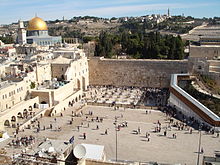Women of the Wall
Women of the Wall ( Hebrew נשות הכותל N'schot ha-Kotel ) is an Israeli women's rights organization that works primarily to ensure that the right of Jewish women is recognized to pray in the entire area of the Western Wall , to wear the tallit and to read from the Torah together .
background
A prayer area is available to women at the Western Wall, which is separated from the men's section by the mechitza and is about a quarter as large. According to Orthodox tradition, women are not allowed there to wear the tallit and the tefilin or to read from the Torah. The Reform Judaism on the other hand also allows women wearing the ritual prayer clothes.
history
In 1988, the first congress of Jewish feminists took place in Jerusalem , and on December 1, 1988, around 100 women from their circle held a public joint prayer with a Torah scroll ( sefer tora ) and Tallitot in the separate women's section at the Western Wall. Despite protests from other men and women, the prayer was brought to an end. The then administrator of the Western Wall, Rabbi Yehuda Gertz , stated that prayer does not violate the rules of Halacha . The prayer ceremonies have been held monthly on Rosh Chodesh ever since .
In the succession, Orthodox Jews repeatedly disrupted the prayers held, sometimes violently . The Israeli Supreme Court decreed after a petition of four women initially banning of prayer with tallit and Torah. In December 1989, the court banned "any religious ceremony at a holy site that is inconsistent with the customs of the site and offends the feelings of believers". Years of legal battle ensued, and in 1994, at the request of the Supreme Court, the Israeli government appointed the Mancal Commission to assess the claims. In 1997, the Commission proposed that prayer be allowed at the Robinson Arch , which borders the Western Wall. That is rejected by WOW. Another commission (Ne'eman Commission) was set up. On June 4, 2001, the Supreme Court ruled that women in principle have the right to pray at the Western Wall, but this right is not unlimited and such a prayer of the WOW is permitted on the Robinson Arch, but not on the wall itself .
In the years that followed, there were repeated arrests of WOW activists for violating this decision. In 2010, 400 international rabbis issued an open letter calling on the Jerusalem police to protect women praying ritually at the Western Wall. In Israel, a social debate arose about religious women's rights in Israel and the relationship between Orthodox Judaism and modern Jewish values.
After a prayer was allowed in the women's section of the Western Wall, women were required to be protected from Orthodox assault by security forces when performing the prayer.
In 2016, the government decided to set up a prayer area for supporters of Reform Judaism .
literature
- Phyllis Chesler, Rivka Haut: Women of the wall: claiming sacred ground at Judaism's holy site . Jewish Lights, 2003.
Web links
- official website
- Jason Miller: Why I Now Support Women of the Wall and Religious Freedom In Israel . In: Huffington Post. February 11, 2013.
Individual evidence
- ↑ a b Paratroopers of '67 protect Women of the Wall '13 . The Israel Times, February 11, 2013.
- ↑ 400 world rabbis ask police to protect women of the wall . Jerusalem Post, November 5, 2010.
- ^ Rethinking Jewish Life: 'For the Sake of Heaven'? . Jerusalem Post, December 27, 2012.
- ^ Israel: Women of the Wall cause tumult at the Western Wall . Spiegel online, May 10, 2013.
- ↑ Gil Yaron : Frevel an der Wailing Wall , in: Die Welt , February 13, 2016, p. 7
